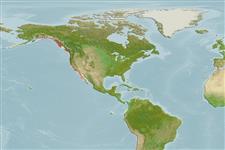Environment: milieu / climate zone / depth range / distribution range
Ökologie
seewasser demersal; tiefenbereich 0 - ? m. Subtropical
Eastern Pacific: Kakul Narrows, southeastern Alaska to St. Nicholas Island and northern Baja California, Mexico.
Size / Gewicht / Alter
Maturity: Lm ? range ? - ? cm
Max length : 6.4 cm TL Männchen/unbestimmt; (Ref. 2850)
Rückenflossenstacheln (insgesamt) : 8 - 10; Rückenflossenweichstrahlen (insgesamt) : 16 - 19; Afterflossenstacheln: 0; Afterflossenweichstrahlen: 13 - 15. Caudal fin barely rounded.
Intertidal (Ref. 31184). Occurs in rocky areas and in kelp beds (Ref. 2850). Usually caught from lower tide pools (farthest from shore) (Ref. 2850). Can leave tide pools when aquatic conditions become inhospitable (Ref. 31184). Breathes air when out of water (Ref. 31184).
Life cycle and mating behavior
Maturities | Fortpflanzung | Spawnings | Egg(s) | Fecundities | Larven
Eschmeyer, W.N., E.S. Herald and H. Hammann, 1983. A field guide to Pacific coast fishes of North America. Boston (MA, USA): Houghton Mifflin Company. xii+336 p. (Ref. 2850)
IUCN Rote Liste Status (Ref. 130435)
Bedrohung für Menschen
Harmless
Nutzung durch Menschen
Tools
Zusatzinformationen
Download XML
Internet Quellen
Estimates based on models
Preferred temperature (Ref.
123201): 8.5 - 17.1, mean 10.1 °C (based on 205 cells).
Phylogenetic diversity index (Ref.
82804): PD
50 = 0.5625 [Uniqueness, from 0.5 = low to 2.0 = high].
Bayesian length-weight: a=0.00676 (0.00300 - 0.01523), b=3.17 (2.98 - 3.36), in cm total length, based on LWR estimates for this (Sub)family-body shape (Ref.
93245).
Trophic level (Ref.
69278): 3.1 ±0.3 se; based on size and trophs of closest relatives
Widerstandsfähigkeit (Ref.
120179): hoch, Verdopplung der Population dauert weniger als 15 Monate. (Preliminary K or Fecundity.).
Fishing Vulnerability (Ref.
59153): Low vulnerability (10 of 100).
